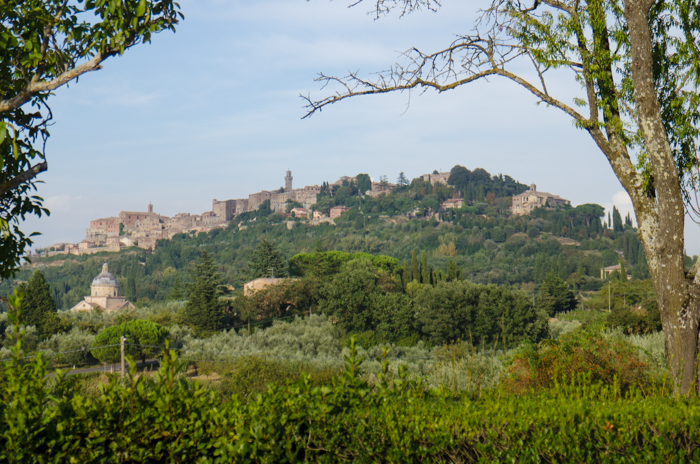 Winding our way through southern Tuscany by bicycle, we arrive in the hill town of Montepulciano. Situated between the Val di Chiana and the Val d’Orcia, and offering views of Lake Trasimeno to the east, and Monte Amiata to the south west, it is a lovely place to while away the afternoon.
Winding our way through southern Tuscany by bicycle, we arrive in the hill town of Montepulciano. Situated between the Val di Chiana and the Val d’Orcia, and offering views of Lake Trasimeno to the east, and Monte Amiata to the south west, it is a lovely place to while away the afternoon.
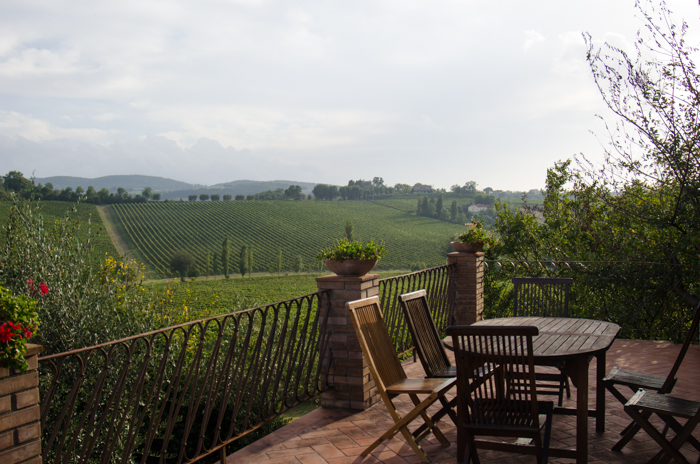 The main street of Montepulciano stretches for just under a mile from the Porta al Prato up hill to Piazza Grande. Car traffic is severely restricted within the 14th century walls of the city. There area several examples of medieval and Renaissance edifices, including the Palazzo Comunale, Palazzo Tarugi, and the Duomo. The lovely church seen just off the hill outside the city is the Sanctuary of the Madonna di San Biagio. For more information on the history of the region, and places to explore in the area, visit www.italiaoutdoors.com.
The main street of Montepulciano stretches for just under a mile from the Porta al Prato up hill to Piazza Grande. Car traffic is severely restricted within the 14th century walls of the city. There area several examples of medieval and Renaissance edifices, including the Palazzo Comunale, Palazzo Tarugi, and the Duomo. The lovely church seen just off the hill outside the city is the Sanctuary of the Madonna di San Biagio. For more information on the history of the region, and places to explore in the area, visit www.italiaoutdoors.com.
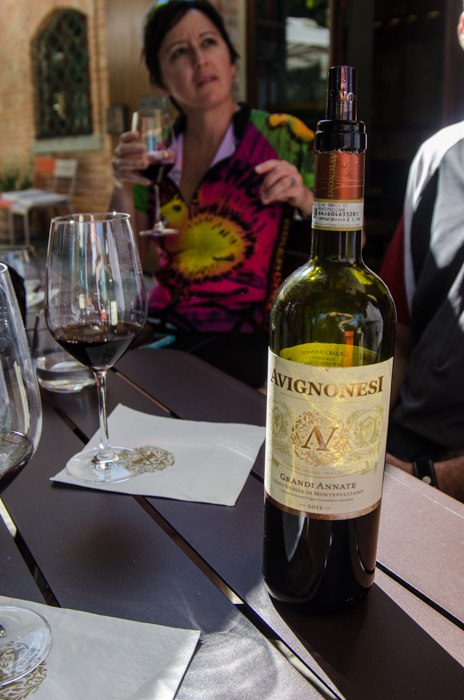 Today the city is most well-known for its wine and unique culinary specialties. On 1st July 1980, Vino Nobile di Montepulciano became the very first Italian wine to earn the Denominazione di Origine Controllata e Garantita (D.O.C.G.) which places it alongside the most prestigious wines in Italy and the world. According to the current production regulations, the basic features of Vino Nobile di Montepulciano are a minimum of 70% of the local Sangiovese clone, called Prugnolo Gentile, blended with up to 30% of other authorized varietals. Like Sangiovese-based Chianti, Vino Nobile is bright with fruit, but with greater depth and intensity of flavors due to Montepulciano’s clay terroir. Vino Nobile is not to be confused with the Montepulciano wine from other regions in Italy, which is produced from the Montepulciano grape.
Today the city is most well-known for its wine and unique culinary specialties. On 1st July 1980, Vino Nobile di Montepulciano became the very first Italian wine to earn the Denominazione di Origine Controllata e Garantita (D.O.C.G.) which places it alongside the most prestigious wines in Italy and the world. According to the current production regulations, the basic features of Vino Nobile di Montepulciano are a minimum of 70% of the local Sangiovese clone, called Prugnolo Gentile, blended with up to 30% of other authorized varietals. Like Sangiovese-based Chianti, Vino Nobile is bright with fruit, but with greater depth and intensity of flavors due to Montepulciano’s clay terroir. Vino Nobile is not to be confused with the Montepulciano wine from other regions in Italy, which is produced from the Montepulciano grape.
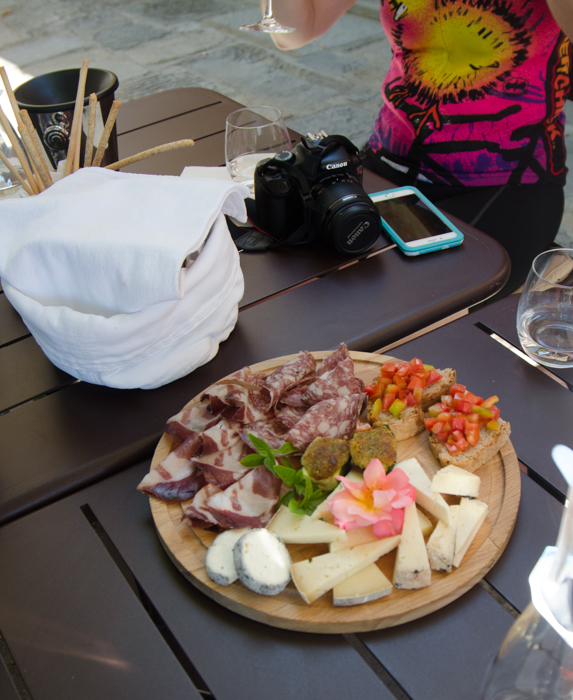 Enjoy the local dishes with your glass of Vino Nobile. Look for prosciutto or other pork dishes from Cinta Senese pigs. Black, with a white stripe around the middle (cinta means belt), these pigs have been raised in this region for hundreds of years, but almost faced extinction not too long ago. Local farmers resurrected the breed, prized for its unique flavors from its diet of foraged roots and nuts, and its high fat content.
Enjoy the local dishes with your glass of Vino Nobile. Look for prosciutto or other pork dishes from Cinta Senese pigs. Black, with a white stripe around the middle (cinta means belt), these pigs have been raised in this region for hundreds of years, but almost faced extinction not too long ago. Local farmers resurrected the breed, prized for its unique flavors from its diet of foraged roots and nuts, and its high fat content.
Pici pasta is found on every restaurant menu, a long thick hand shaped spaghetti topped with tomato (al pomodoro), garlic (all’aglione) or a ragu of cinghiale (wild boar) or coniglio (rabbit). Fall brings tagliatelle topped with fresh porcini.
For those craving a steak fix, the Bistecca alla Fiorentina will more than satisfy. The cattle from the Val di Chiana, Chianina, are the largest cattle in the world, large white beasts that served as working stock until fairly recently. Bring a large appetite, or a friend to share – these steaks are priced by the 1/10 of a kilogram, and usually run about 1 kilo minimum size, over 2 pounds. They are best grilled, and served rare, seasoned simply with salt and pepper.
My colleague, Vernon McClure, has developed a very comprehensive guide site, www.italiaoutdoors.com, on the history, geography, culture, outdoor activities and general travel in Italy.
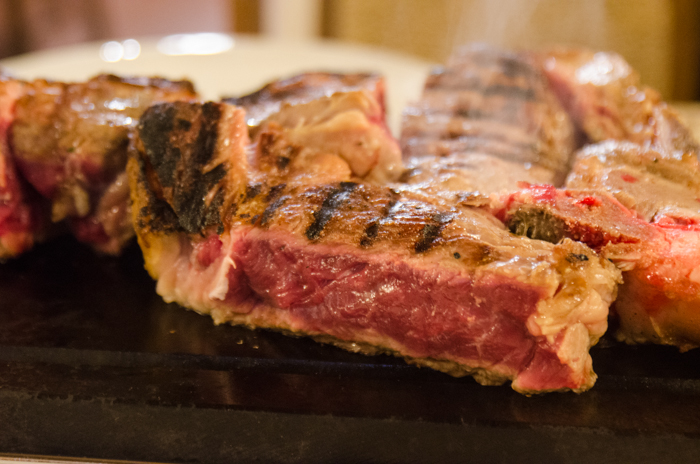

Pingback: Avignonesi - Exploring the Wines of Montepulciano | Italian Food, Wine, and Travel
Pingback: Peperoni Con Capperi – Sauteed Peppers With Capers | Italian Food, Wine, And Travel
Pingback: Peperoni con Capperi – Sauteed Peppers with Capers | Italian Food, Wine, and Travel